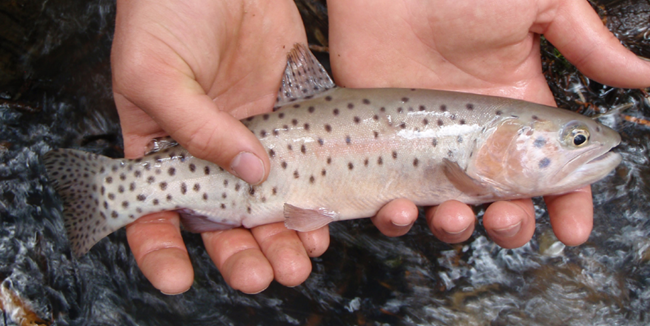Part of a series of articles titled The Midden - Great Basin National Park: Vol. 15, No. 1, Summer 2015.
Article
Park Partners with NDOW to Restore Native Fish
This article was originally published in The Midden – Great Basin National Park: Vol. 15, No. 1, Summer 2015.

NPS Photo
Bonneville cutthroat trout (BCT) are relicts from ancient Lake Bonneville. When the lake was at its fullest, about 15,000 years ago, its shores were only a few miles from the eastern slopes of the Snake Range. As Lake Bonneville receded, the BCT had no choice but to take refuge in the perennial streams that flowed into the diminishing lake. BCT persisted in these mountain streams for thousands of years until settlers began to stock them with non-native brook, brown, and rainbow trout. These non-native species quickly outcompeted and hybridized with most of the BCT populations in the Snake Range.
In the early 1990s the Nevada Department of Wildlife (NDOW) started an aggressive BCT restoration program on BLM and Forest Service lands in the North Snake Range. They removed all of the non-native trout and reintroduced BCT in Smith, Deadman, Deep Canyon, Hampton, and Hendry’s Creeks. Currently, Silver Creek is the only North Snake Range stream within the BCT’s native range that has not been restored as a native fishery. However NDOW, with a little assistance from Great Basin National Park, has already made great strides to remedy this.
In 2012, NDOW constructed a rock gabion fish barrier on Silver Creek ensuring that any non-native fish existing downstream could not migrate upstream into the future BCT restoration area. In August of 2013, Great Basin National Park staff assisted NDOW to execute their carefully planned chemical renovation of the Silver Creek drainage. The four day treatment utilized 30 drip stations, several spray/sanding crews, and one johnboat to eradicate all nonnative fish from Silver Creek and its reservoir. Shortly after, sterile tiger trout were released into the reservoir to provide the public with a recreational fishery until BCT become established in the system. The following summer, Park staff assisted NDOW with their validation surveys to ensure the treatment was 100% successful. Over several weeks, three to four person electrofishing crews surveyed Silver Creek and all of its tributaries and confirmed that no living fish (with the exception of the tiger trout) remained in the drainage.
With the treatment confirmed to be a success, NDOW is now excited to reintroduce native BCT back into Silver Creek. In June of 2015, NDOW and the Park’s Resource Management Department will work together to collect as many BCT as possible from Snake Creek. The BCT will be loaded into insulated tanks equipped with aerators and oxygen gas, transported to the Silver Creek drainage, and then released at predetermined locations. In the years following the reintroduction, the BCT population in Silver Creek will be closely monitored to ensure that it is growing at a satisfactory rate. Population augmentations can be performed using BCT from other North Snake Range streams if necessary. A few years from now, BCT should be distributed throughout the Silver Creek drainage, establishing another conservation population and providing the public with a productive native fishery.
Over the last decade, Great Basin National Park and NDOW have formed a strong partnership to achieve their common goal of restoring BCT throughout their native range and protecting them for future generations to enjoy. The Park is proud to have played a role in restoring BCT to the Silver Creek drainage and is excited to continue working closely with NDOW in the future.
Last updated: March 22, 2024
